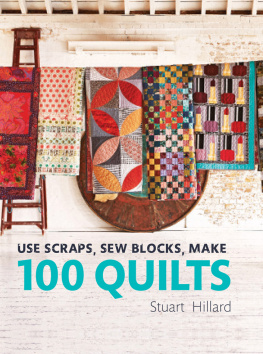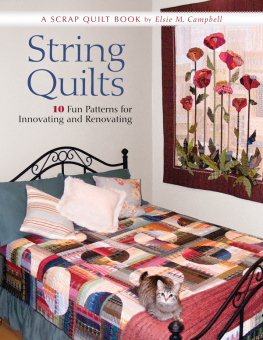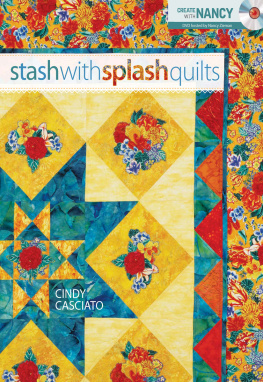Contents
Guide



Utility-Style
Quilts for Everyday Living
Copyright 2017 by Landauer Publishing, LLC
Projects Copyright 2017
by Sharon Holland
This book was designed, produced,
and published by
Landauer Publishing, LLC
3100 100th Street, Urbandale, IA 50322
515/287/2144 800/557/2144 landauerpub.com
President/Publisher: Jeramy Lanigan Landauer
Editor: Doris Brunnette
Art Director: Laurel Albright
Graphic Designer: Sharon Holland
Photographers: Sue Voegtlin, Sharon Holland, and Susan Playsted
All rights reserved. No part of this book may be reproduced or transmitted in any form by any means, electronic or mechanical, including photocopying, recording, or by any information storage and retrieval system without permission in writing from the publisher with exception that the publisher grants permission to copy the template patterns in this book for personal use only. The scanning, uploading and distribution of this book or any part thereof, via the Internet or any other means without permission from the publisher is illegal and punishable by law. The publisher presents the information in this book in good faith. No warranty is given, nor are results guaranteed.
Library of Congress Control Number: 2017952648
ISBN: 978-1-935726-97-5
eISBN: 978-1-607656-09-8
Landauer Books are distributed to the Trade by
Fox Chapel Publishing
1970 Broad Street
East Petersburg, PA 17520
www.foxchapelpublishing.com
1-800-457-9112
For consumer orders:
Landauer Publishing, LLC
3100 100th Street
Urbandale, Iowa 50322
www.landauerpub.com
1-800-557-2144

CONTENTS


Regularity, order, desire for perfection destroy art. Irregularity is the basis of all art.
Pierre-Auguste Renoir
INTRODUCTION
Everyday use and functionality is the true meaning of Utility-Style. A quilt put into service, laundered, and eventually worn to threads is loved. For the patterns in this book, I challenge you to remove the expectation for perfection and embrace utility and its unexpected, fail-proof, scrappy beauty. As Pierre-Auguste Renoir once said, Regularity, order, desire for perfection destroy art. Irregularity is the basis of all art. Likewise, Leo Tolstoy eloquently said, If you look for perfection, youll never be content. Embrace these words when selecting fabrics and block arrangements and you will find freedom as an artist. Unlike show quilts that are sewn to be admired on a wall or saved for special occasions like creative trophies, utility quilts are born from a humbler beginning. Once liberated of the need for flawlessness the quilter is free to experiment without pressure, make mistakes, and more importantly, use without worry.
This book welcomes you with a dozen designs inspired by timeless quilt block patterns. Create cozy quilts using surprising fabric and color combinations to put a new spin on tradition making each quilt eternally modern. The patterns herein are fast-pieced and great for beginners. You will find the quilts range from simple-pieced to more involved patchwork blocks as well as skill-building design tips and innovative suggestions for expanding upon the samples. The projects vary in size from baby quilts to queen size quilts. If you like a design but want it smaller make fewer blocks. Likewise, if you desire a larger quilt make more blocks. The beauty of a scrap quilt is that no one will know if youve run out of fabric and had to make substitutions!
Fabric requirements in this book are written for the stated size sample. Yardage is given in total increments because some quilts incorporate material from garments, vintage, or stash fabrics that range in width. The fabrics you select therefore may vary, so a total yardage is helpful when gathering materials.
As you stitch your quilts from start to finish using this book remember to free yourself of the idealism of the perfect quilt. Instead, experiment with color, print, and block orientation, and embrace the quirkiness that comes from working with scrap and stash materials. Most of all enjoy living with your usably-modern quilts everyday!

SEWING SUPPLIES
There are a multitude of gadgets and tools on the market with the quilt maker in mind. These are the essentials recommended for successful patchwork sewing. See , for additional list of quilting supplies.
BASIC SEWING SUPPLIES
Rotary cutter, mat, and acrylic ruler A rotary cutter and cutting mat work in conjunction with acrylic rulers. These tools are designed to cut layers of fabric quickly and accurately. The projects in this book all begin with cutting strips of fabric with a rotary cutter. A large self-healing cutting mat will protect your work surface and provide a grid ruler for cutting and squaring up fabric. Clear acrylic rulers are thicker than standard rulers and come in many shapes and sizes. Choose rulers with 1/8" increments. Selecting a 24" long ruler 6" wide or larger and a 6-1/2" or larger square ruler are good sizes to start with.
Sewing Machine A sewing machine that sews an accurate 1/4" seam is a must for quilting. Make sure your machine is in good working order with proper thread tension for durable seam construction. Having the ability to sew with the needle in the down position is advantageous to better piecing. Attachments like a walking foot or darning foot are helpful when machine quilting on a sewing machine.
Thread Use high quality thread for long-lasting seams and less lint deposits in your sewing machine. Choose a neutral thread color for piecing. I like to use a medium 50-weight thread for patchwork sewing and machine quilting. For piecing cotton, 100% cotton thread is best and a poly-blend or 100% polyester thread is recommended for machine quilting.
Needles Select an all-purpose or quilting needle for your sewing machine. Change the needle often (after every big project) for best machine performance. Never sew over pins. Instead, stop with the needle in the down position, remove the pin, and continue sewing. Signs that a needle should be changed include: skipped or uneven stitches, a popping sound when the needle meets the fabric, uneven or skipped stitches.
Straight Pins Quilting pins are long with a thin shaft and sharp point.
Scissors, Shears, and Seam Ripper Fabric scissors and shears should be kept separate from household scissors and used only for fabric. Cutting paper and other materials can dull the blades. Shears are generally longer than scissors and meant to cut thicker fabrics. Having a small pair of sharp scissors and a pair of 8" dressmakers shears should be part of any sewing room. Because mistakes happen youll also want to have a seam ripper available for tearing out seams.





















